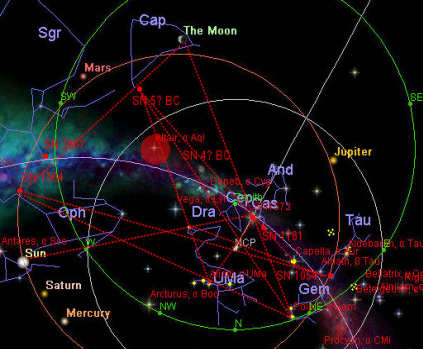|
|
| f80v, cropped, middle section, Voynich Manuscript. Credit: Beinecke Rare Book and Manuscript Library, Yale University. Overlay by P. Han showing suggested interpretation of folio images. |
f80V
|
|
| f80v, cropped, middle section, Voynich Manuscript. Credit: Beinecke Rare Book and Manuscript Library, Yale University. Overlay by P. Han showing suggested interpretation of folio images. |
I suggest this represents the position of SN 1572 in relation to the North Pole and specifically Draco and Gemini. The “dragon” representing Draco and the nymph under it holding an astronomers ring which was used to measure the altitude of stars, representing the North Pole/Polaris. The nymph above the “dragon” is holding an unknown device in the same way as other apparent astronomical instruments suggesting it is another but undetermined astronomical instrument, possibly measuring the position of SN 1572 in relation to its position close to the point where the Celestial Zero Meridian and Galactic Equator cross.
|
|
| f80v, cropped, top section, Voynich Manuscript. Credit: Beinecke Rare Book and Manuscript Library, Yale University. Overlay by P. Han showing suggested interpretation of top folio images. |
The nymph under the nymph holding the astronomer’s ring may be Capella in Auriga, a very distinct star due to its brightness which lies directly below SN 1572 in a horizon based view. Capella, and Etamin the brightest star in Draco, line up very close to Polaris. The constellations and stars I have suggested infer a mix of horizon based star map and Chinese style North Pole based map is described in this folio as the head of Draco is above the Zenith at this time as viewed from the horizon but Capella, Castor and Pollux line up more accurately viewed from the horizon. Together they give an accurate position of Polaris, Capella directly below SN 1572 and Castor and Pollux on the horizon that together point directly to SN 1572.
I suggest the bottom of the image showing three nymphs on the left, the central nymph and nymph on the right show the position of SN 1572 on the Central Zero Meridian in relation to Polaris and the three brightest stars or the three tail stars of Ursa Major.
|
|
| f80v, cropped, bottom section, Voynich Manuscript. Credit: Beinecke Rare Book and Manuscript Library, Yale University. Overlay by P. Han showing suggested interpretation of bottom folio images. |
Below comparison of Horizon based and North Pole centred star maps for comparison and stars that may have be used to triangulate the position of SN 1572.
|
|
|
| Credit: Redshift6. Horizon based star map, 11/11/1572, over Scania (formerly in Denmark). Overlay by P. Han showing possible relation to f80v folio images and the triangulation of SN 1572. | Credit: Redshift6. North Pole centred star map 11/11/1572, over Scania (formerly in Denmark). Overlay by P. Han showing possible relation to f80v folio images and the triangulation of SN 1572. |
As an extension of this proposal the image below shows the relationship of SN 1572, Draco, Ursa Major, Gemini and Capalla and Polaris to SN 1054 and SN 5 BC (?) in Capricorn. Capella, Polaris and Etamin are a common locating SN 1054 and SN 5 BC (?) in this way. On f85v, which I have suggested describes SN 1572 as seen by Tycho Brahe. There is a view of the supernova involving the Moon or its direction which from a horizon view of the sky is not very relevant but if SN 5 BC (?) in Capricorn is one of the subjects in the manuscript, then it becomes more relevant as as well as lining up with Gemini through SN 1572 the Moon is also located in Capricorn at this time. Next to it an image shows these relationships extended to include SN 1604, the Sun and the Moon. SN 1604 does not appear to be specifically referred to in the manuscript but there are possible oblique references and the missing pages may contain SN 1604 as subject matter.
|
|
 |
| Credit: Redshift6. North Pole centred star map 11/11/1572, over Scania (formerly in Denmark). Overlay by P. Han showing the relationship of SN 1572, Draco, Ursa Major, Gemini and Capalla and Polaris to SN 1054. | Credit: Redshift6. North Pole centred star map 11/11/1572, over Scania (formerly in Denmark). Overlay by P. Han showing the relationship of SN 1572, Draco, Ursa Major, Gemini and Capalla and Polaris to SN 1054 and SN 5 BC (?) in Capricorn. |
Copyright © 2010 P. Han